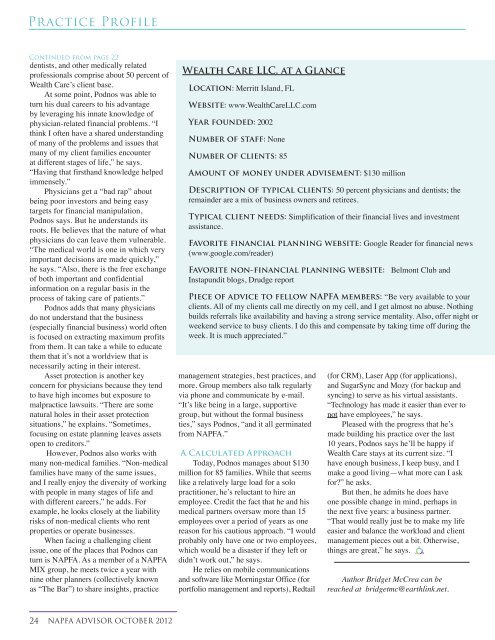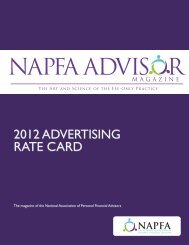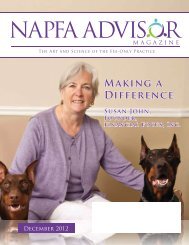Q&A with Kelli Hueler: - Napfa
Q&A with Kelli Hueler: - Napfa
Q&A with Kelli Hueler: - Napfa
You also want an ePaper? Increase the reach of your titles
YUMPU automatically turns print PDFs into web optimized ePapers that Google loves.
Practice Profile<br />
Continued from page 22<br />
dentists, and other medically related<br />
professionals comprise about 50 percent of<br />
Wealth Care’s client base.<br />
At some point, Podnos was able to<br />
turn his dual careers to his advantage<br />
by leveraging his innate knowledge of<br />
physician-related financial problems. “I<br />
think I often have a shared understanding<br />
of many of the problems and issues that<br />
many of my client families encounter<br />
at different stages of life,” he says.<br />
“Having that firsthand knowledge helped<br />
immensely.”<br />
Physicians get a “bad rap” about<br />
being poor investors and being easy<br />
targets for financial manipulation,<br />
Podnos says. But he understands its<br />
roots. He believes that the nature of what<br />
physicians do can leave them vulnerable.<br />
“The medical world is one in which very<br />
important decisions are made quickly,”<br />
he says. “Also, there is the free exchange<br />
of both important and confidential<br />
information on a regular basis in the<br />
process of taking care of patients.”<br />
Podnos adds that many physicians<br />
do not understand that the business<br />
(especially financial business) world often<br />
is focused on extracting maximum profits<br />
from them. It can take a while to educate<br />
them that it’s not a worldview that is<br />
necessarily acting in their interest.<br />
Asset protection is another key<br />
concern for physicians because they tend<br />
to have high incomes but exposure to<br />
malpractice lawsuits. “There are some<br />
natural holes in their asset protection<br />
situations,” he explains. “Sometimes,<br />
focusing on estate planning leaves assets<br />
open to creditors.”<br />
However, Podnos also works <strong>with</strong><br />
many non-medical families. “Non-medical<br />
families have many of the same issues,<br />
and I really enjoy the diversity of working<br />
<strong>with</strong> people in many stages of life and<br />
<strong>with</strong> different careers,” he adds. For<br />
example, he looks closely at the liability<br />
risks of non-medical clients who rent<br />
properties or operate businesses.<br />
When facing a challenging client<br />
issue, one of the places that Podnos can<br />
turn is NAPFA. As a member of a NAPFA<br />
MIX group, he meets twice a year <strong>with</strong><br />
nine other planners (collectively known<br />
as “The Bar”) to share insights, practice<br />
Wealth Care LLC, at a Glance<br />
Location: Merritt Island, FL<br />
Website: www.WealthCareLLC.com<br />
Year founded: 2002<br />
Number of staff: None<br />
Number of clients: 85<br />
Amount of money under advisement: $130 million<br />
Description of typical clients: 50 percent physicians and dentists; the<br />
remainder are a mix of business owners and retirees.<br />
Typical client needs: Simplification of their financial lives and investment<br />
assistance.<br />
Favorite financial planning website: Google Reader for financial news<br />
(www.google.com/reader)<br />
Favorite non-financial planning website: Belmont Club and<br />
Instapundit blogs, Drudge report<br />
Piece of advice to fellow NAPFA members: “Be very available to your<br />
clients. All of my clients call me directly on my cell, and I get almost no abuse. Nothing<br />
builds referrals like availability and having a strong service mentality. Also, offer night or<br />
weekend service to busy clients. I do this and compensate by taking time off during the<br />
week. It is much appreciated.”<br />
management strategies, best practices, and<br />
more. Group members also talk regularly<br />
via phone and communicate by e-mail.<br />
“It’s like being in a large, supportive<br />
group, but <strong>with</strong>out the formal business<br />
ties,” says Podnos, “and it all germinated<br />
from NAPFA.”<br />
A Calculated Approach<br />
Today, Podnos manages about $130<br />
million for 85 families. While that seems<br />
like a relatively large load for a solo<br />
practitioner, he’s reluctant to hire an<br />
employee. Credit the fact that he and his<br />
medical partners oversaw more than 15<br />
employees over a period of years as one<br />
reason for his cautious approach. “I would<br />
probably only have one or two employees,<br />
which would be a disaster if they left or<br />
didn’t work out,” he says.<br />
He relies on mobile communications<br />
and software like Morningstar Office (for<br />
portfolio management and reports), Redtail<br />
(for CRM), Laser App (for applications),<br />
and SugarSync and Mozy (for backup and<br />
syncing) to serve as his virtual assistants.<br />
“Technology has made it easier than ever to<br />
not have employees,” he says.<br />
Pleased <strong>with</strong> the progress that he’s<br />
made building his practice over the last<br />
10 years, Podnos says he’ll be happy if<br />
Wealth Care stays at its current size. “I<br />
have enough business, I keep busy, and I<br />
make a good living—what more can I ask<br />
for?” he asks.<br />
But then, he admits he does have<br />
one possible change in mind, perhaps in<br />
the next five years: a business partner.<br />
“That would really just be to make my life<br />
easier and balance the workload and client<br />
management pieces out a bit. Otherwise,<br />
things are great,” he says.<br />
Author Bridget McCrea can be<br />
reached at bridgetmc@earthlink.net.<br />
24<br />
<strong>Napfa</strong> Advisor October 2012







